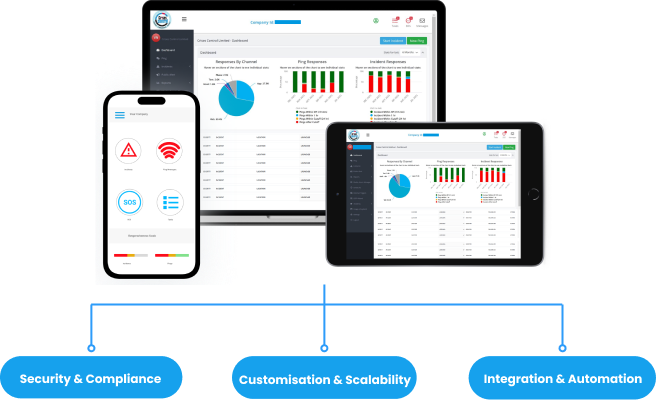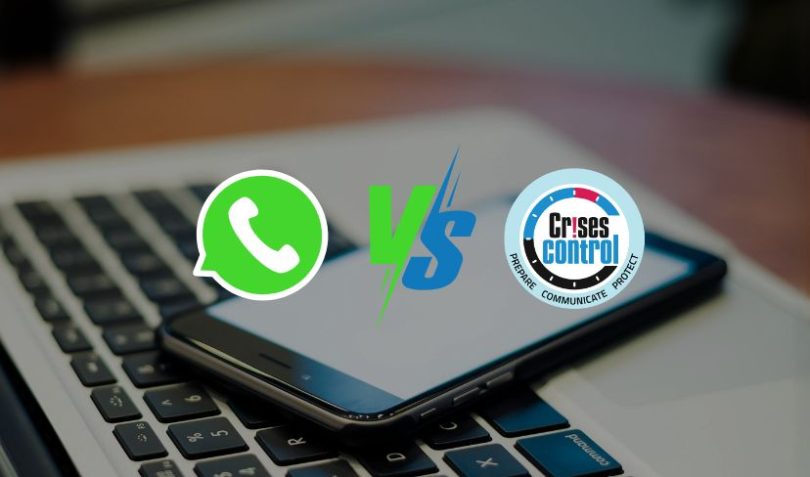In today’s hyper-connected world, crises aren’t just possible, they’re inevitable. From cyberattacks and natural disasters to operational disruptions and security breaches, organisations must be prepared to respond quickly and effectively. In the heat of the moment, every second counts. This is where the critical role of emergency notification apps comes into play.
While platforms like Whatsapp might seem like a convenient communication tool, relying on them for crisis management is like using a bicycle to climb Mount Everest – it might get you there, but it’s not optimal, and the risks are high. That’s where specialised emergency notification apps like Crises Control come in, offering robust features and security measures that Whatsapp simply can’t match.
Understanding the Need for Emergency Notification Apps
In times of crisis, every second counts. Emergency notification apps are specifically designed to deliver critical information swiftly and reliably to designated recipients.
Unlike conventional messaging platforms, these apps offer features tailored to crisis situations, including mass notifications, two-way communication, real-time tracking, and integration with other emergency systems.
Imagine a scenario like a natural disaster – an emergency notification app would allow you to instantly send out alerts to everyone in your organisation, confirm their safety, and coordinate response efforts effectively.
The Advantages of Emergency Notification Apps
Real-time Alerts and Status Updates
During emergencies, stakeholders need timely updates and clear directives to make informed decisions. Emergency notification apps empower organisations to send real-time alerts and status updates, keeping everyone informed and coordinated. Whether it’s a natural disaster, security breach, or operational disruption, instant communication can mitigate risks and minimise the impact of crises.
Imagine a power outage affecting your entire facility – with an emergency notification app, you can instantly send updates on restoration efforts and ensure everyone remains calm and informed.
Enhanced Coordination and Collaboration
Effective crisis management relies on seamless coordination and collaboration among team members, departments, and external partners. Emergency notification apps facilitate two-way communication, enabling recipients to acknowledge alerts, provide status updates, and collaborate on response efforts in real-time.
Imagine coordinating evacuation efforts across multiple floors during a fire emergency – an emergency notification app would enable real-time communication between building occupants, security personnel, and first responders, facilitating a swift and coordinated response.
Comprehensive Reporting and Analytics
Post-incident analysis is essential for evaluating the effectiveness of crisis response strategies and identifying areas for improvement. Emergency notification apps offer robust reporting and analytics capabilities, allowing organisations to track response times, monitor user engagement, and assess the overall performance during crises.
Imagine analysing data after a cyberattack to understand how quickly employees reported suspicious activity or how effective communication efforts were – valuable insights to strengthen your future preparedness.
Why Whatsapp Falls Short in Crisis Situations
Let’s face it, Whatsapp is designed for personal chats and group conversations, not mission-critical communication. Here’s why it falls short in a crisis:
- Security Concerns: Whatsapp has faced widespread scrutiny over its data privacy practices and lack of end-to-end encryption. In a crisis scenario, secure communication is paramount, and Whatsapp simply doesn’t deliver.
- Limited Features: Whatsapp offers basic messaging functionalities, but lacks crucial features like real-time tracking, two-way communication, and integrated workflows. These are essential for coordinating response efforts and keeping everyone informed.
- Scalability Issues: Whatsapp doesn’t scale well for large-scale emergencies. Imagine trying to send mass notifications to thousands of employees or stakeholders during a crisis – it would be chaotic and inefficient.
- Compliance Challenges: Many industries have strict regulations governing crisis communication. Whatsapp doesn’t offer the tools or capabilities to ensure compliance with these regulations.
Crises Control VS Whatsapp

Security and Compliance
When it comes to sensitive information and crisis-related communications, security is non-negotiable. Crises Control offers end-to-end encryption and adherence to industry standards, including SOC 2 Type II and HIPAA compliance.
In contrast, Whatsapp has faced scrutiny over its data privacy practices and lacks the level of security required for enterprise-level crisis management.
Imagine storing confidential employee information or evacuation plans on a platform with documented security vulnerabilities – a risky gamble in a crisis scenario.
Customisation and Scalability
Emergency notification apps like Crises Control provide customisable features to adapt to the unique needs of different organisations. From defining escalation procedures to creating predefined message templates, users have the flexibility to tailor the platform to their specific requirements.
Whatsapp, on the other hand, offers limited customisation options and may not scale effectively for large-scale crisis scenarios.
For instance, imagine needing to send personalised evacuation instructions to thousands of employees across multiple locations – Whatsapp’s limitations would quickly become apparent.
Integration and Automation
Seamless integration with existing systems and automation of routine tasks are essential for streamlining crisis response efforts. Crises Control offers APIs and integrations with various platforms, allowing for automated alerts, incident reporting, and data synchronisation.
Imagine automatically triggering safety protocols upon detecting a fire alarm or streamlining communication with first responders during a critical incident – functionalities simply not available in Whatsapp.
It’s Time to Upgrade Your Crisis Management Game
While Whatsapp might be sufficient for casual chats, relying on it for crucial crisis communication is a gamble you simply can’t afford to take. Emergency notification apps like Crises Control offer the security, features, and scalability you need to navigate any crisis with confidence. They empower you to respond swiftly, coordinate effectively, and mitigate risks proactively.
Don’t wait for the next crisis to hit. Take charge of your organisation’s preparedness and resilience. Contact Crises Control today for a free demo and discover how we can help you weather any storm.
Remember, when it comes to crisis management, preparation is key. By choosing the right tools and adopting a proactive approach, you can turn even the most challenging situations into opportunities for resilience and growth.
Request a Free Demo
Interested in our Emergency Notification App?
FAQs
1. Why should I choose an emergency notification app over Whatsapp for crisis management?
Emergency notification apps like Crises Control offer specialised features tailored to crisis situations, including real-time alerts, two-way communication, and integration with other emergency systems. Unlike Whatsapp, which is designed for personal communication, these apps provide robust security measures, scalability, and compliance features essential for effective crisis management.
2. What security concerns exist when using Whatsapp for crisis communication?
Whatsapp has faced scrutiny over its data privacy practices and lacks end-to-end encryption, making it vulnerable to security breaches and unauthorised access to sensitive information.
In contrast, emergency notification apps like Crises Control offer Fort Knox-level security with end-to-end encryption and adherence to industry standards, ensuring confidential data remains protected during crises.
3. How do emergency notification apps facilitate coordination and collaboration during crises?
Emergency notification apps enable seamless coordination and collaboration among stakeholders by providing features such as two-way communication, real-time status updates, and task management. These functionalities empower organisations to coordinate response efforts effectively, share critical information, and collaborate with internal teams and external partners in real-time, enhancing overall crisis management capabilities.
4. What advantages do emergency notification apps offer in terms of scalability and customisation?
Emergency notification apps like Crises Control offer customisable features that allow organisations to tailor the platform to their specific requirements, including defining escalation procedures and creating predefined message templates.
Moreover, these apps scale effortlessly to accommodate large-scale emergencies, enabling organisations to send mass notifications to thousands of employees or stakeholders instantly, regardless of their location.
5. How do emergency notification apps help organisations ensure compliance with industry standards and regulations?
Emergency notification apps like Crises Control provide built-in features and reporting tools that help organisations demonstrate compliance with industry standards and legal requirements governing crisis communication. With features such as comprehensive reporting and analytics, organisations can track response times, monitor user engagement, and assess overall performance during crises, ensuring adherence to regulatory requirements and industry best practices.
